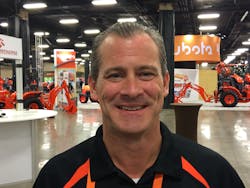Three Questions With...Paul Manger, Kubota Construction Equipment's Product Marketing Director
Another in a series of byte-sized one-on-one visits with construction industry insiders. Manger is the highest-ranking American in Kubota's construction equipment organization, and was a key figure during the company's recent unveiling of its new skid steer line.
1. Why are you getting into the skid steer business now?
We’ve always sold excavators; I think that as a Japanese company, selling excavators is a natural fit, and excavators were a kind of common platform that you see in Europe and you see in Asia. But this [North American] market is very unique in that it has skid steers and compact track loaders. So Kubota had decided some years ago that we really needed to expand our construction equipment line, and that just having excavators alone wasn’t going to be enough to fully compete. The first product out was the CTL, and that was a hot product when it really started to take off in the mid-2000s, so it was decided that was where we were going to start off. Well, the plan always was to move into the skid steers and skid steers were already a very mature market that wasn’t going to get any more mature, so it made sense to start with the compact track loader first, and then follow it up with the skid steer loader.
2. I notice that you’ve started with hand and foot controls and you’ve promised pilot controls in a couple of years; why not start with pilot controls since that’s the state of the art right now?
Pilot controls are the state of the art, but we’re very concerned about having a product, entering it [into the market] right, and having the parts and the expertise to take care of it. A mechanical linkage and hand and foot controls is a simple operating system, and pilot is more complex. It’s not going to be a couple of years; at next year’s dealer meeting we’re going to announce pilot controls, so it’s just going to be a one-year delay. The younger generation now, they’re using pilot controls, yet still half the market is hand-and-foot. If you had to start with one, it makes sense to start here. This is something that the dealers are going to be able to grasp a little quicker, a little sooner, and we’re going to be sure that we get on board with something that we can [service], we want to get into this slow and gradual—we want to do it right. We don’t want to have any issues.
3. Two unique things about these skid steers are the slide-up entry door, and making the fuel tank part of the back service door. Why do you think these are winning ideas?
As far as the roll-up door, that was incorporated into the compact track loader and you’ll see other competitors have that in the track loader, and [the benefit’s] just obvious. When we had it in the CTL, it was accepted by the market, everyone really liked the door. And when we started to look at what the competitors were doing on their skid steers, they all had the swing-out door. And clearly, the roll-up door is more convenient. We think it’s a much, much better feature, so why not incorporate it into the skid steer? It seems natural to do that.
With the fuel tank…how do you make this machine easy to service, easy to get at, and then how do you protect the vital elements? First of all, we have heavy doors, so that fuel tank is protected, but when you look at the configuration of how we lay out the components, by putting that fuel tank in the door, we’ve opened up the machine. It’s very easy to service, it’s very easy to fuel, at the same time, we’ve put that in the door and it gives us a better layout so that we can reach and work on those components. It ends up making the layout of the machine much simpler.
About the Author
Frank Raczon
Raczon’s writing career spans nearly 25 years, including magazine publishing and public relations work with some of the industry’s major equipment manufacturers. He has won numerous awards in his career, including nods from the Construction Writers Association, the Association of Equipment Manufacturers, and BtoB magazine. He is responsible for the magazine's Buying Files.

